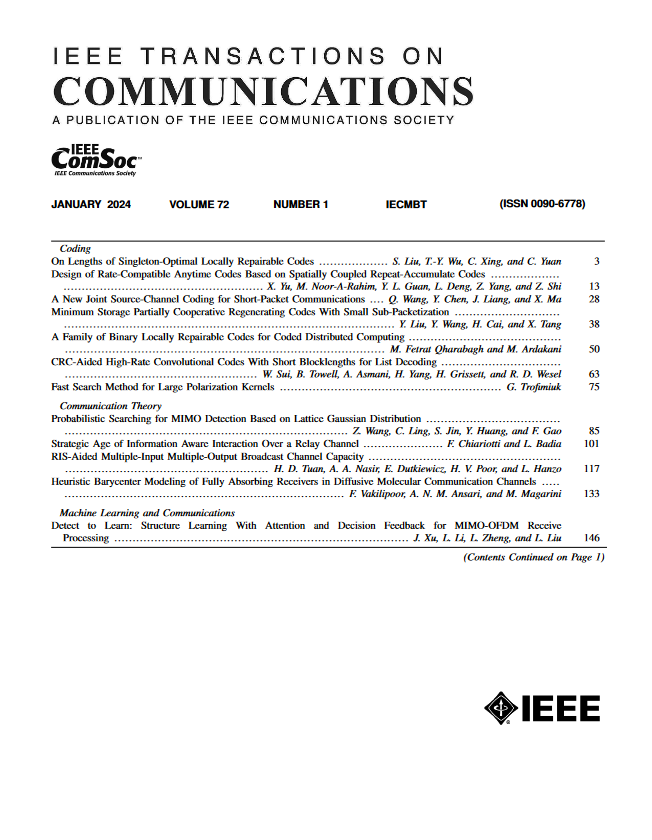Joint Offloading and Beamforming Design in Integrating Sensing, Communication, and Computing Systems: A Distributed Approach
IF 8.3
2区 计算机科学
Q1 ENGINEERING, ELECTRICAL & ELECTRONIC
引用次数: 0
Abstract
When applying integrated sensing and communications (ISAC) in future mobile networks, many sensing tasks have low latency requirements, preferably being implemented at terminals. However, terminals often have limited computing capabilities and energy supply. In this paper, we investigate the effectiveness of leveraging the advanced computing capabilities of mobile edge computing (MEC) servers and the cloud server to address the sensing tasks of ISAC terminals. Specifically, we propose a novel three-tier integrated sensing, communication, and computing (ISCC) framework composed of one cloud server, multiple MEC servers, and multiple terminals, where the terminals can optionally offload sensing data to the MEC server or the cloud server. The offload message is sent via the ISAC waveform, whose echo is used for sensing. We jointly optimize the computation offloading and beamforming strategies to minimize the average execution latency while satisfying sensing requirements. In particular, we propose a low-complexity distributed algorithm to solve the problem. Firstly, we use the alternating direction method of multipliers (ADMM) and derive the closed-form solution for offloading decision variables. Subsequently, we convert the beamforming optimization sub-problem into a weighted minimum mean-square error (WMMSE) problem and propose a fractional programming based algorithm. Numerical results demonstrate that the proposed ISCC framework and distributed algorithm significantly reduce the execution latency and the energy consumption of sensing tasks at a lower computational complexity compared to existing schemes.集成传感、通信和计算系统中的联合卸载和波束成形设计:一种分布式方法
在未来移动网络中应用集成传感与通信(ISAC)时,许多传感任务具有低延迟要求,最好在终端上实现。然而,终端通常具有有限的计算能力和能源供应。在本文中,我们研究了利用移动边缘计算(MEC)服务器和云服务器的先进计算能力来解决ISAC终端的感知任务的有效性。具体来说,我们提出了一个新的三层集成传感、通信和计算(ISCC)框架,该框架由一个云服务器、多个MEC服务器和多个终端组成,其中终端可以选择将传感数据卸载到MEC服务器或云服务器。卸载消息通过ISAC波形发送,ISAC波形的回波用于检测。我们共同优化了计算卸载和波束形成策略,以最小化平均执行延迟,同时满足感知需求。特别地,我们提出了一种低复杂度的分布式算法来解决这个问题。首先,利用乘法器的交替方向法(ADMM),导出了卸载决策变量的闭型解。随后,我们将波束形成优化子问题转化为加权最小均方误差(WMMSE)问题,并提出了一种基于分数规划的算法。数值结果表明,与现有方案相比,所提出的ISCC框架和分布式算法在较低的计算复杂度下显著降低了感知任务的执行延迟和能耗。
本文章由计算机程序翻译,如有差异,请以英文原文为准。
求助全文
约1分钟内获得全文
求助全文
来源期刊

IEEE Transactions on Communications
工程技术-电信学
CiteScore
16.10
自引率
8.40%
发文量
528
审稿时长
4.1 months
期刊介绍:
The IEEE Transactions on Communications is dedicated to publishing high-quality manuscripts that showcase advancements in the state-of-the-art of telecommunications. Our scope encompasses all aspects of telecommunications, including telephone, telegraphy, facsimile, and television, facilitated by electromagnetic propagation methods such as radio, wire, aerial, underground, coaxial, and submarine cables, as well as waveguides, communication satellites, and lasers. We cover telecommunications in various settings, including marine, aeronautical, space, and fixed station services, addressing topics such as repeaters, radio relaying, signal storage, regeneration, error detection and correction, multiplexing, carrier techniques, communication switching systems, data communications, and communication theory. Join us in advancing the field of telecommunications through groundbreaking research and innovation.
 求助内容:
求助内容: 应助结果提醒方式:
应助结果提醒方式:


